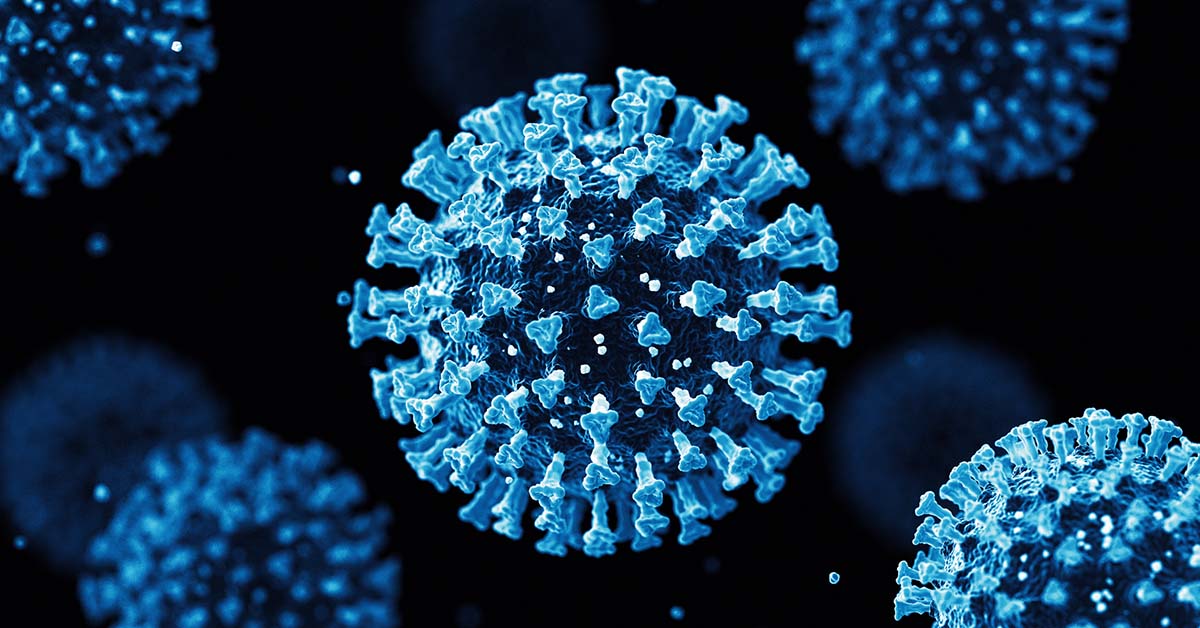Covid-19: About the Virus

SARS-CoV-2 is a novel coronavirus that causes the disease, Covid-19. Coronaviruses are a large family of viruses that can infect animals and humans. SARS-CoV-2 is similar to the viruses that cause SARS-CoV-1 (Severe Acute Respiratory Syndrome 1) and MERS-CoV (Middle East Respiratory Syndrome). Coronaviruses, named for the crown-like spikes protruding from their surfaces, circulate among animals such as pigs, camels, bats, and cats. SARS-CoV-2 is thought to have originated in bats and likely infected an intermediate host before transmitting to a human. [1] This is known as a spillover event, defined as the event in which a virus is transmitted from one species to another.
[1] Lau S, Luk H, Wong A, et al. Possible Bat Origin of Severe Acute Respiratory Syndrome Coronavirus 2. Emerging Infectious Diseases. 2020;26(7):1542-1547.
Symptoms
Covid-19 has wide-ranging clinical manifestations from asymptomatic infection to life-threatening respiratory failure and multi-organ dysfunction. Some of the common symptoms reported are
- Fever
- Cough
- Muscle soreness
- Fatigue
- Diarrhea
- Headache
- Shortness of breath
- Sore throat
- Chills
- Sudden loss of taste or smell
Other clinical manifestations of Covid-19 can also include blood clots, strokes, inability to wake or stay awake, new confusion, bluish lips or face, encephalopathy, acute hypoxemic, sepsis and septic shock, and delirium.
Long-lasting Covid-19 symptoms have also been reported. Recent research indicates damage to lung, cardiac, and neurological function can persist for months after infection with SARS-CoV-2.[1,2]
The serious and disparate impacts of Covid-19 can be attributed to the angiotensin-converting enzyme 2 or ACE2 mechanism that pervades the whole body. SARS-CoV-2 uses the ACE2 receptor to facilitate viral entry into human cells, enabling the virus to infect many organs throughout the body.[3] At this time, it is unclear whether these impacts are temporary or permanent.
[1] Zhao et al., Follow-up study of the pulmonary function and related physiological characteristics of Covid-19 survivors three months after recovery. The Lancet EClinical Medicine, 2020.
[2] Carfi et al., Persistent Symptoms in Patients After Acute Covid-19, JAMA, 2020;324(6):603-605.
[3] Gheblawi et al., Angiotensin-Converting Enzyme 2: SARS-CoV-2 Receptor and Regulator of the Renin-Angiotensin System, Circulation Research, 2020;126:1456–1474
Transmission
SARS-CoV-2 spreads easily from person to person. Overwhelming scientific evidence points to aerosol transmission as the significant and predominant mode. Aerosols, which are particles suspended in air, can be emitted by an infected person through breathing, talking, singing, coughing, and sneezing.[1] Asymptomatic individuals, for instance, can spread infectious SARS-CoV-2 aerosols during breathing and speaking, without coughing or other respiratory symptoms. Aerosols can also be generated during medical procedures such as intubation and bronchoscopy.
Respiratory particles vary in size; larger aerosol particles can remain suspended in the air for several minutes, while smaller or lighter ones can linger in the air for hours and travel through the room and ventilation systems. Perfume spray or cigarette smoke demonstrates the extent of aerosol plume distribution as it can be smelled from a distance for quite some time as the particles disperse throughout the room.
Studies about SARS-CoV-2 satisfy the criteria for classifying an infectious disease as airborne – the virus must be transmitted via aerosol particles less than 5 µm in diameter and be capable of causing infection. A recent study has found that SARS-CoV-2 can survive and remain infectious for at least 16 hours suspended in aerosols.[2] Researchers have also recovered infectious SARS-CoV-2 in the air from hospital rooms with Covid-19 patients, collected at nearly 16 feet away. Airborne SARS-CoV-2 particles were less than 5 µm in diameter and were detected in the absence of a cough or aerosol generating procedures.[3,4]
[1] Jones, R.M. and L.M. Brosseau, Aerosol transmission of infectious disease. Journal of Occupational and Environmental Medicine, 2015. 57(5): p. 501-8.
[2] Fears, Alyssa C. et al., Persistence of Severe Acute Respiratory Syndrome Coronavirus 2 in Aerosol Suspensions, Emerging Infectious Diseases, 2020;26(9):2168-2171.
[3] Santarpia et al., The Infectious Nature of Patient-Generated SARS-CoV-2 Aerosol, medRxiv, 2020.
[4] Lednicky et al., Viable SARS-CoV-2 in the air of a hospital room with Covid-19 patients. International Journal of Infectious Diseases, 2020.
More About the Virus
Bibliography
View the full National Nurses United Covid-19 bibliography here.